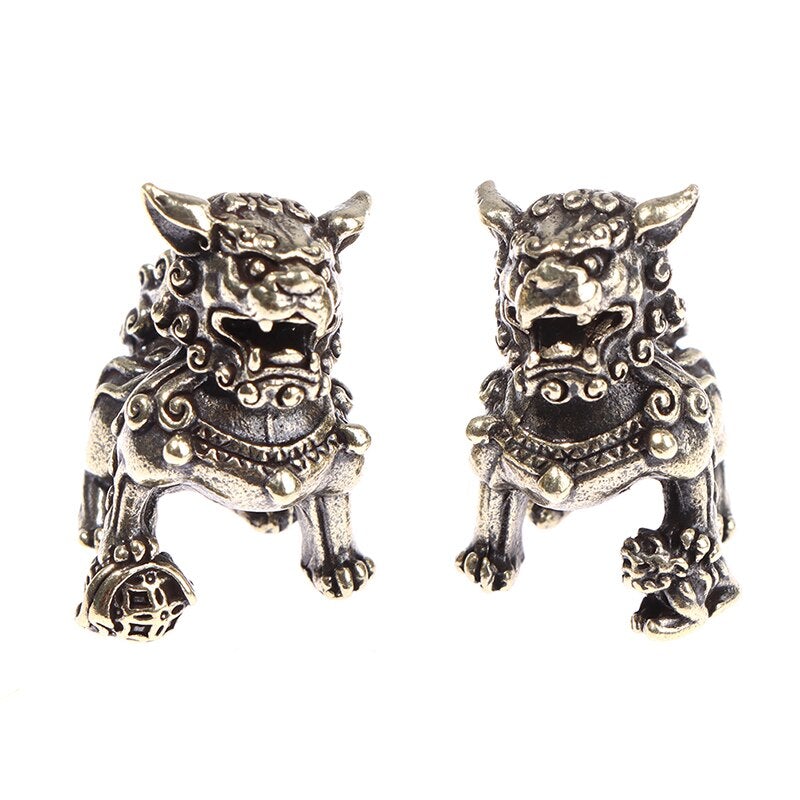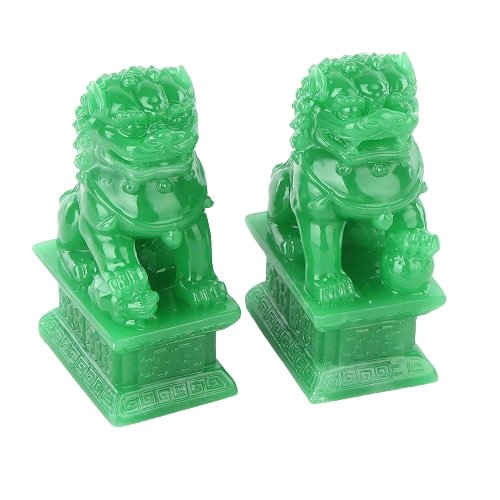The Secrets of Fu Dog: the Legendary Chinese Lion
Fu dogs are ancient creatures, guardians of Imperial China. Sometimes also called Chinese lions, these stone sculptures have guarded the entrances to temples and palaces for centuries.
Placed in front of their doors, they send a clear messenger to anyone who would like to enter the building: “We are here, and we are guarding this place!” ».
Thus, the fu dog is part of the long and glorious history of China and Asia. Like many elements of Asian culture, this figure has a deep meaning (which we will try to decipher in this article) and stems from ancient traditions.
You will see it here: unraveling the meaning of the Chinese lion can be an effective way to better grasp the soul of the Mandarin people.
Contents :
Description of this Chinese lion
An emblematic example: the guardian statues of the Forbidden City

Description of this Chinese lion
Traditionally, fu dogs are massive sculptures made of stone and mounted on heavy bases decorated with engraved symbols that scholars call xumizuo.
When we look at their physique, it can be difficult for us to make the connection with the lion we know, and that's completely normal!
In reality, despite their nickname Chinese lion, these creatures are not related to the king of the jungle.
Their appearance therefore comes from myths where they are described to us as imposing dogs with bulging eyes and mischievous smiles, whose curly fur and wide open roaring mouths command respect and leave a feeling of great ferocity.
Look at these statuettes that we offer on our site and you will see better what we want to talk about.
Most often, fu dogs live in pairs (consisting of a male and a female), thus ensuring balance and harmony. Sometimes also, a large pearl is found in their mouth to represent their sacred breath.
As we have already stated, the material most often used in their construction is stone.
However, some models can be made of bronze, marble or even gold and jade. Thus, a fu dog statue can be used by its owner to display their wealth and power.
Despite many similarities, Chinese lions can have different styles depending on the period in which they were designed and the dynasty that ruled the Middle Kingdom at that time.
For example, statues erected during the Han dynasty or during the Tang era are large, imposing and massive. Those from the Yuan dynasty on the other hand will be slimmer and muscular. The later dynasties of imperial China (namely the Ming and Qing) instead produced fu dogs with a calm and peaceful appearance, as if to show a certain wisdom acquired over centuries of existence.
Use and Meaning of Fu Dog
The lion as presented to us here is one of the best-known creatures in Chinese mythology.
Many legends present him as a benevolent being who would work together with man to chase away evil spirits.
Chinese traditions and customs are numerous, varied and sometimes even contradict each other.
Thus, accurately determining the meaning of the Chinese lion is a real challenge. However, here we have tried to compile some answers commonly accepted by the Chinese themselves.

Yin-yang duality
It’s clear: the Chinese lion is a figure full of symbolism. Often, as we have said, they are found in pairs.
The female is often represented placing her paw on the back of a cub, thereby illustrating the yin side, the inner power of the feminine pole of the world. The qualities then associated with it are quiet strength, compassion, care for loved ones and healing.
It is therefore the female who protects the building in front of which she is, and those who are inside.
Next to her, we have the male who places his paw on an imperial sphere, a great symbol of power and influence in imperial China. You guessed it: it evokes the yang side, the desire for conquest and domination. The associated qualities here are strength, power, courage and ferocity.
He then uses these abilities to ward off evil spirits and energies.
This duality is particularly well marked in this pair of statuettes, the two dogs being perfectly symmetrical to each other if it is not what their paw overcomes.
We can analyze this by saying that it is he among the pair of fu dogs who repels negative energies and demons.
Thus, like yin and yang, the two Chinese lions balance each other and work together to provide us with the best possible benefits.

The hunter of negative energy
The fu dog apparently has the ability to "cleanse the shar chi", a negative force that Chinese sages identified as emanating from objects that are too sharp corners, crowds that are too compacted, and structures that protrude from the ground in unnatural ways (such as example street lamps).
This may seem a little “esoteric” to us with our Western glasses, but this idea of energy circulation facilitated or, on the contrary, prevented by decorations and furniture is an ancient idea of the Chinese people.
They have been studying the issue for thousands of years, having developed real expertise!
Concretely, Chinese lions are powerful entities whose perception, and the ability to discern good and bad intentions make them excellent guardians.
Excellent yes, but also fierce and sometimes wild, hence the need to show them respect.
Thus, it would be this ability to dissipate negative energy which would explain why the Chinese initially placed fu dogs at the entrance to their temples and or at the feet of their statues. For example, here are some photos of Chinese lions found in the famous Forbidden City.
Seeing their effectiveness as a good luck charm, the phenomenon then spread to the palaces and houses of rich merchants.

A balancing element
A bit in the same vein as the previous theory, the fu dog would have the capacity to balance energies and, thereby, overly impetuous temperaments. Thus, its simple presence would reduce the number of thefts, fights and even road accidents.
Through this link with balance (the famous “Middle Way” so dear to Asians), the Chinese lion would also keep away people with too bad souls whose only intention is to harm.
With this in mind, placing this type of Chinese lucky charm in front of the doors of a business or a business could keep thieves and scammers away, ultimately promoting the prosperity and wealth of the owner.
In fact, this idea may be more widespread than we might think…
Restaurants, hotels, factories, offices: many of these places choose to trust the fu dog. Simple traditions for some, others claim that the reason for this is much more concrete and down-to-earth.

Meaning of the Chinese lion in Feng Shui
Given the scope of the phenomenon, many different traditions have become interested in dog fu.
Among these, Feng Shui is particularly interested in the influence of the material on the powers of the fu dog and as such teaches us some interesting ideas.
Placing a pair of metal Chinese lions next to a door facing North or West is a good idea. Indeed, this type of door is linked to the water element... which will benefit from the metal element of the statues to potentiate its effects.
Placing ceramic fu dogs (white if you want to take advantage of their effects) inside a living room will bring a graceful touch to the room. In fact, their curves and shapes tend to make the energy more delicate.
Jade is, according to the doctrine of Feng Shui, a powerful material whose simple presence protects us from many evils and curses.
A fu dog made of jade will therefore be a powerful protective Chinese lucky charm that will find its place almost anywhere.

An emblematic example: the guardian statues of the Forbidden City
The many tourists who visit China each year have no shortage of wonders to visit.
From the Great Wall to Buddhist temples and pagodas, to the superb ultra-modern megacities, there is something for everyone.
In the midst of all this, the Forbidden City takes on a special meaning.
Built around 6 centuries ago during the reign of the Ming dynasty (1368-1644), when the emperor decided to move his capital, this tourist site is one of the best preserved, and also one of the most magnificent, from medieval China.
While a whole bunch of treasures were destroyed or moved following British colonization in the 19th century, the Forbidden City stands out as an exception with the numerous works of art that it has managed to preserve.
What connection with the dog will you tell us? The answer is actually quite simple.
The most famous (and undoubtedly the most difficult to miss) of these treasures are undoubtedly the two statues of guardian lions which are placed at the entrance.
The male lion, with his paw placed on the globe, represents the emperor's domination over all of China.
The lioness plays with her cubs, showing the fertility of the country's lands and rivers.
For many specialists, the fu dogs of the Forbidden City represent what could be the most grandiose in the Middle Kingdom.

Some additional tips for properly placing your dogs fu
Before finishing this article, we had to give you some additional advice.
To ensure that their effects are favorable to you, you must follow certain rules when you place your pair of Chinese lions in your home.
Tradition teaches us that misuse of this type of tool can sometimes have catastrophic consequences.
The field of Chinese lucky charms (of which you will find some examples here) is rich and can offer us great powers, that's clear. However, it is important to keep in mind that improper use of any of them can be dangerous; even very dangerous.
In short, here are the main instructions that we have to give you:
- Fu dogs must always be paired together to ensure their harmony. Separating them would be a serious mistake.
- They must be placed on a perfectly flat and horizontal surface. This is also the reason why they are often mounted on pedestals or stone bases.
- If you decide to place them next to your front door, the Chinese lions should be placed on either side of it, again according to a certain search for balance.
- More precisely, the male should be placed to the right of the door, and the female to the left.
- You can place your fu dogs both outdoors and indoors. In this second case, however, they will have to stay in the same room. (Even if they are close in terms of distance, they should not be separated by a wall or a door jamb for example.
Lucky charms featured in this article

Copper Fu Dog Statuettes
See more
Pair of Aventurine Fu Dogs
See more

